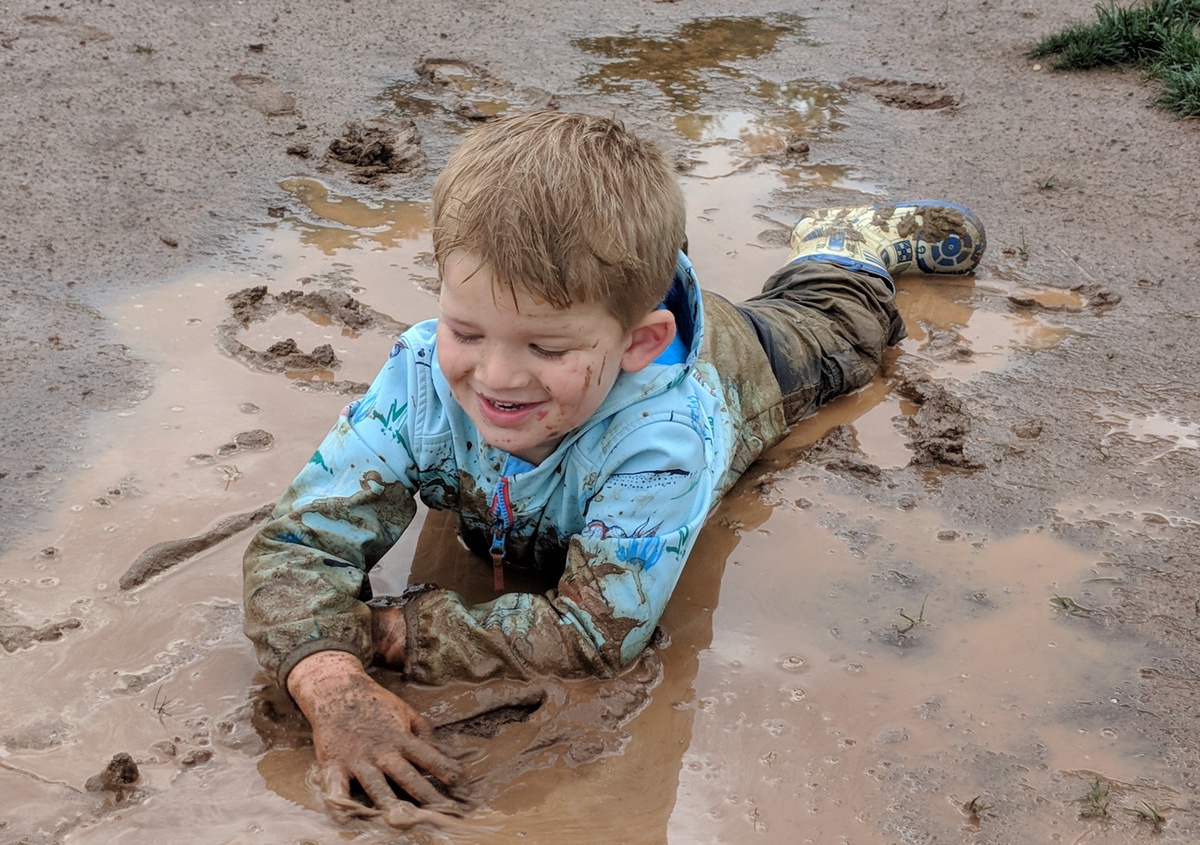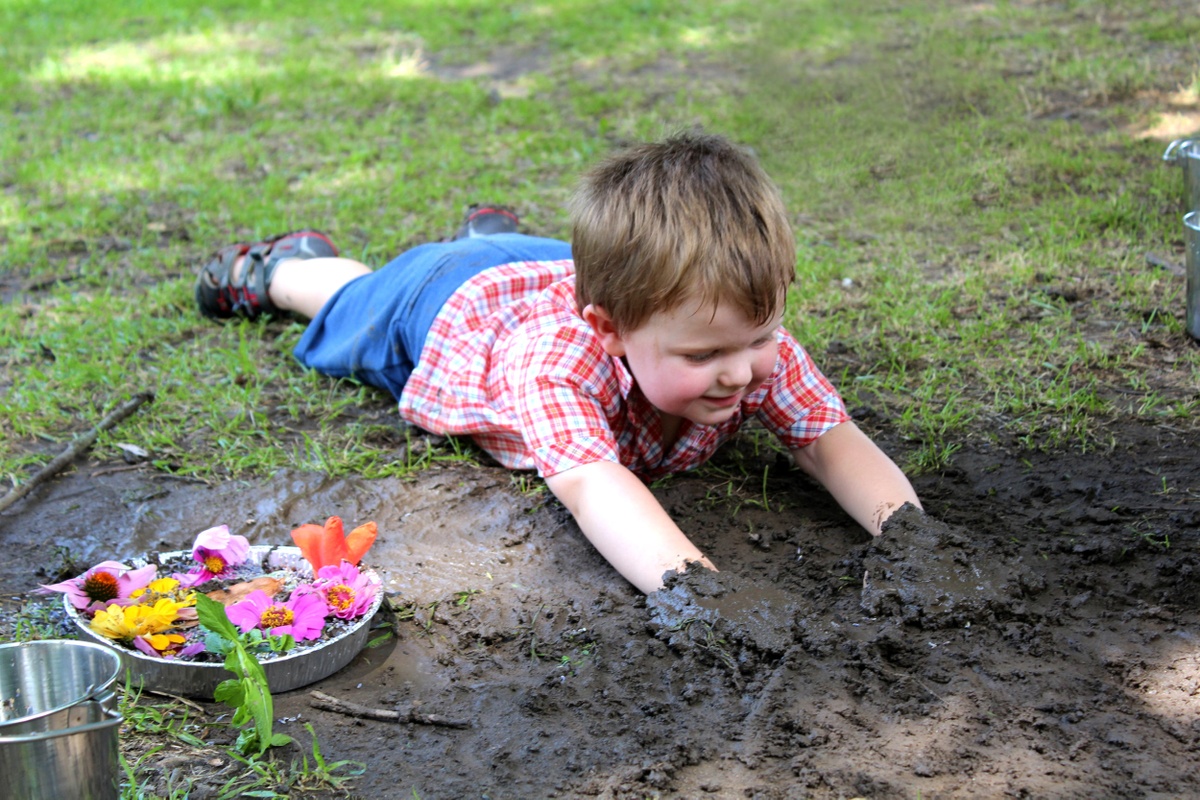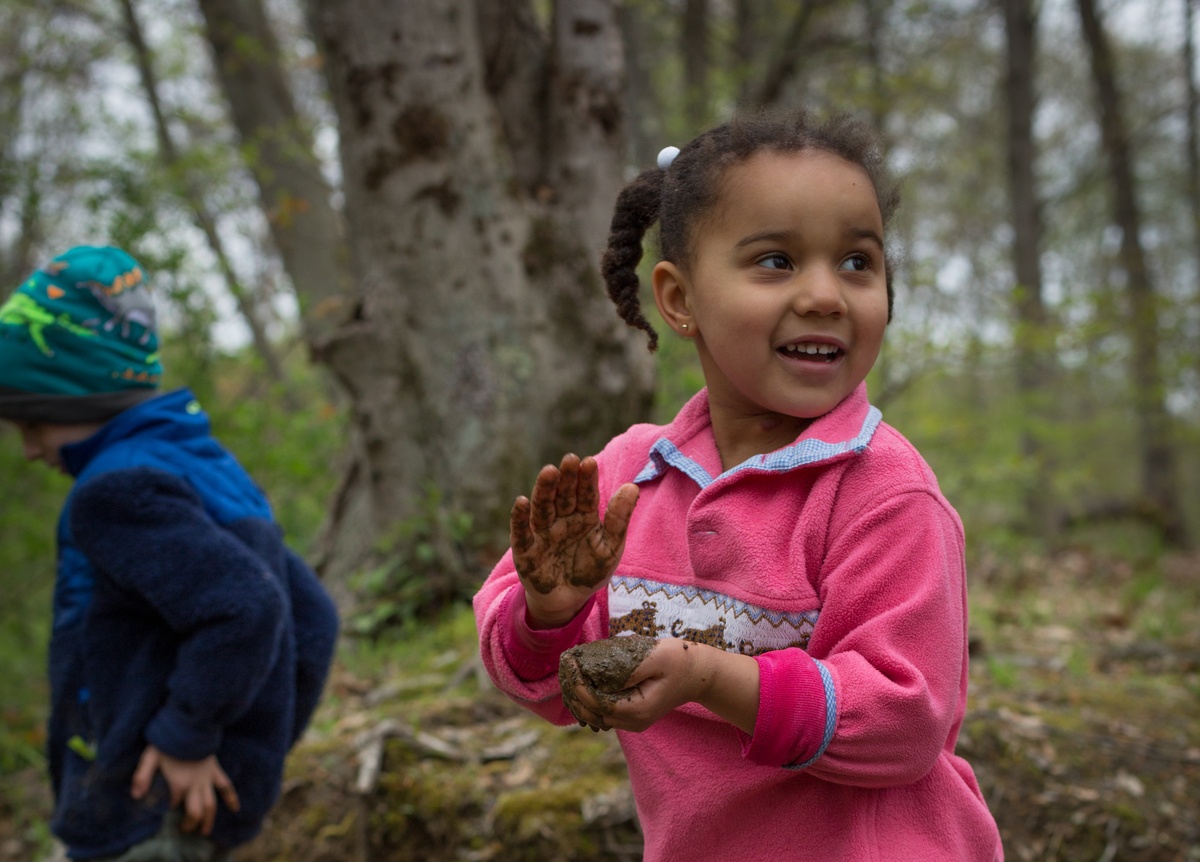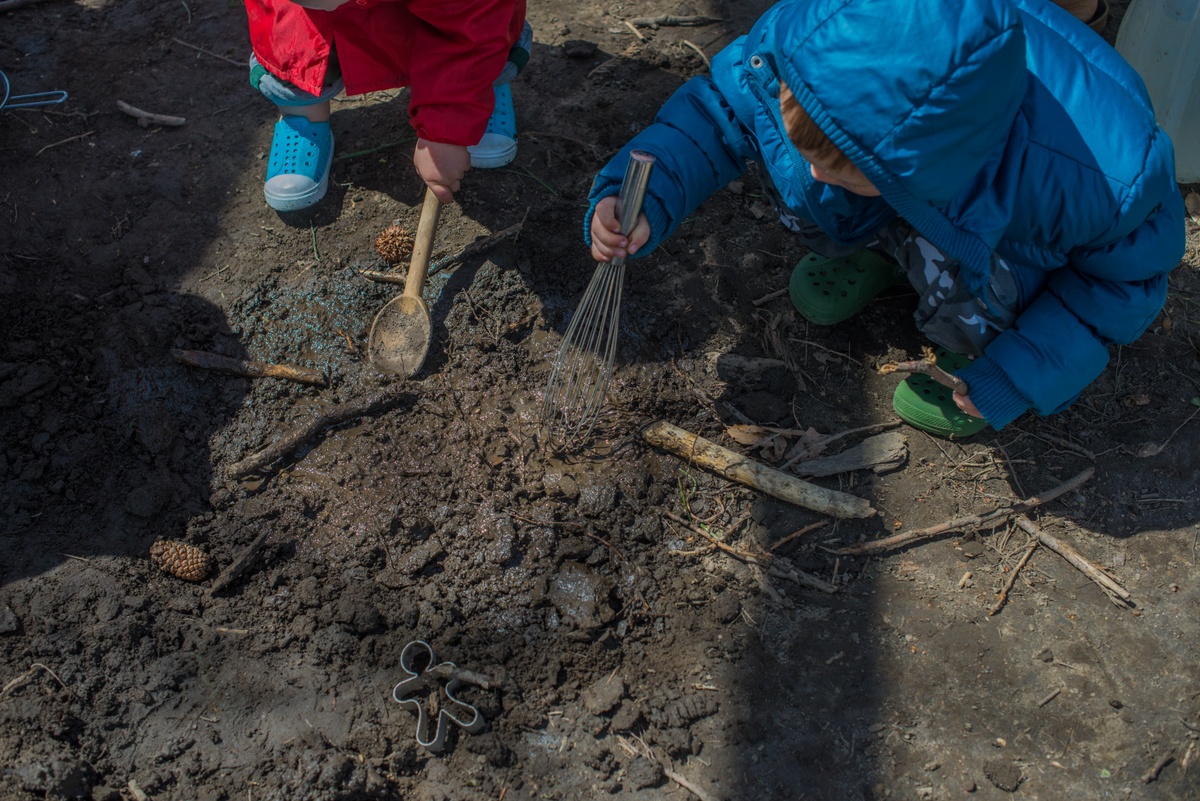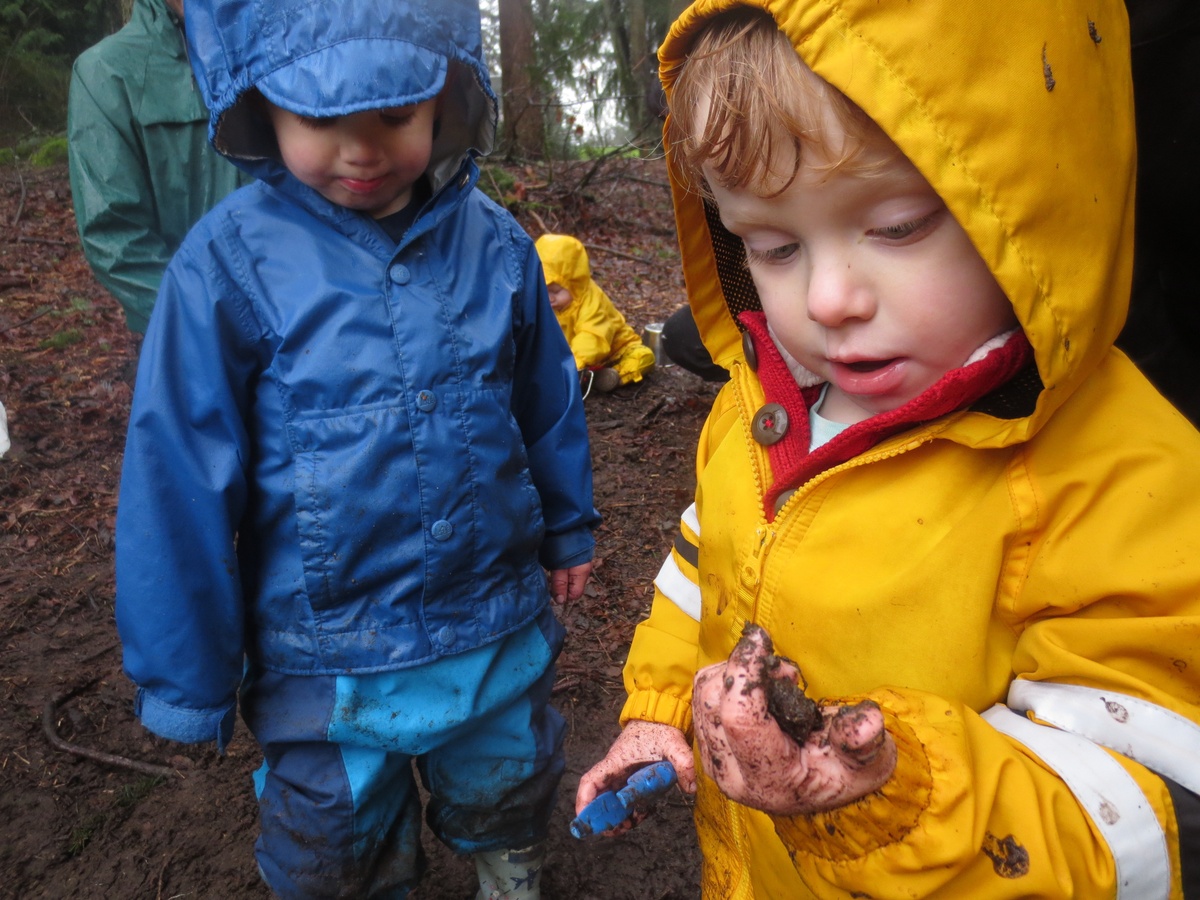Tinkergarten leaders have logged tens of thousands of lessons designed around kids playing in mud. Each time, kids and their adults have learned together in the mud, and our team has also learned a whole lot about how different children approach mud play.
For many children, playing and experimenting with mud immediately inspires joy and curiosity, while others need to ease in. Once kids are in, mud play offers myriad benefits. First, it’s the ultimate tool for creating—it can be paint, cement, soup, balls to toss and more. Mud play also strengthens multiple senses, stimulating sight, sound and, of course, touch. The better kids are able to tune and integrate their senses, the more effectively they can learn.
What’s more, playing in the mud can keep you healthy and happy! Special bacteria in dirt not only stimulate the immune system, but also give our brains a jolt of the endorphin serotonin; that helps to make us feel calm and relaxed.
Children’s approaches to mud are not fixed. Parents frequently say that their child’s comfort with and interest in mud blossomed over the course of a Tinkergarten season. Kids also get a range of messages from the adults around them about messes and what it means to get dirty. When kids are given a clear “OK” to enjoy the dirt, they generally do—especially if that’s reinforced over time.
In class, Tinkergarten Leader Emma Gardner saw her daughter’s mud mindset transform.
“When we first started Tinkergarten, my daughter hardly touched the mud and now, she literally dives in and rolls around!” she said. “She also recites to herself, ‘It's OK to get dirty because we can always get clean.’”
Many young kids also switch mindsets from day to day, depending on which side of the bed they rolled out on.
For all of these reasons, each child approaches mud in their own way. The most important thing to do in support of them is to follow their lead. It can also help to see if kids align with one of four common “mud mindsets” and align your support around one of these approaches:
Mud Enthusiast
“I light up when I realize it’s a mud day at Tinkergarten. I likely go ‘all in’ up to my elbows and even kick off my shoes to let my toes get in the action, too. Mud, oh how I love you!”
Support the Mud Enthusiast by: Offering lots of opportunities for mud play. We know that mud enthusiasts can make a lot of laundry for us, so have a “to-go bag” with water for play, change of clothes, soapy water and an old towel for easy clean-up by the door to make it easy to head out for mud play whenever the inspiration hits. Have space in your yard? Consider setting up a mud kitchen to spark hours of independent play.
Mud Manager
“I get really excited to play in the mud, but I also like to keep it under control. Maybe I just need a few minutes to ease into mud play. Maybe I need to keep mud in a more controlled state—it’s when I get rushed right into the soupy, oozey, sloppy mud that my cup overflows a bit. As long as I feel in control, the mud days are my faves.”
Support the Mud Manager by: Giving them all the time they need to warm up and ease into play. Be sure to take a minute to “warm up your mud hands” before play starts, and never rush the process. You can also suggest or model making mud balls, which tend to be more dry and are more contained than soupy mud. If mud gets really watery, suggest adding a bit more dirt. Have water nearby; sometimes just knowing it’s possible to wash off and revert to “normal” gives a kid all the control and comfort they need.
Tool User
“I love a good “stick in the mud,” in the best possible way. Using tools and objects to squish, stir and shape the mud feels satisfying, and that still counts! I don’t need to get my hands dirty to have a good time. And, sometimes tools give me just the space I need to fall in love with mud.”
Support the Tool User by: Offering a variety of tools for mud play. Sticks, spoons and containers of various sizes will offer your child the chance to explore and create with mud without getting their hands dirty. Keep a bucket of water or a wet washcloth nearby for your child to clean off hands without having to disrupt the play.
Mud Averse
“I truly am of the mind that mud is just. Too. Much. I may be interested in watching how others play with mud and want to play nearby or alongside them, but I do not feel inclined to jump into the mud myself.”
Support the Mud Averse by: Listening to them. Honoring that self-awareness. Start with water play and let that be the sensory experience on mud day—no dirt required. Leaving the door open and being sure to allow them around mud and especially around other kids who are interacting joyfully with mud. Kids often do not feel left out; they do not have expectations of conformity for themselves that we have for them. They know who they are and what they want. Just adapt the environment to support their mindset today.
Alternative Ways to Fill Kids’ Cups
Make the following sensory-stimulating play alternatives available to all kids, letting them know that this choice will be right near, but will stay mud-free. These are also great options for families whose access to washing and drying is limited, especially during COVID-19, when shared laundry spaces may be difficult to access:
- a bucket or bin of rice
- bucket of water and scoops and cups
- soapy water
- rocks with different textures
- dry leaves
Supporting Your Mud Mindset
When supporting kids’ mud mindsets, remember that your mindset makes a difference! Here are a few tips for grown-ups:
- Ask kids, “how do you want to play today?” This reminds them that they have agency and that each day is a new opportunity.
- Warm up mud (or water) hands. When we prime a part of the body, we are better able to process the information we take in with that part of the body. Before diving into mud play, invite your child to warm up their mud hands by rubbing them together. Remember, this helps you too!
- Follow kids’ lead. Cue off of your child and stay steady. Be open to their mindset changing at any moment, too.
- Ask yourself: “What is my mud mindset?” How do I feel about mud, and how do I want to play today? Your needs and preferences are valid, too! Remember that whatever your tolerance for (and ability to engage in) mud play, even a small amount of exposure to this sensory-rich activity reaps rewards.
